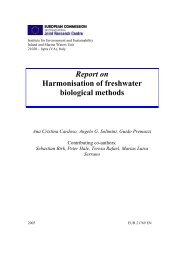Lakes and Watercourses
Lakes and Watercourses
Lakes and Watercourses
Create successful ePaper yourself
Turn your PDF publications into a flip-book with our unique Google optimized e-Paper software.
Chlorophyll-a concentrations refer to seasonal means (May –<br />
October) over three years, based on monthly readings taken in the epilimnion<br />
or, if only one sample is taken, surface water (0.5 m). Alternatively,<br />
August readings taken over three years can be used, although<br />
account must then be taken of the relatively high variation from one year<br />
to another, particularly in eutrophic environments (class 4 <strong>and</strong> 5). The<br />
chlorophyll concentrations represent the intervals on the phytoplankton<br />
scale <strong>and</strong> the corresponding interval on the total phosphorus scale. The<br />
chlorophyll concentration has been assumed to constitute 0.5 per cent of<br />
plankton volume. Discrepancies in relation to the concentration of total<br />
phosphorus depend on lake depth, among other things.<br />
TABLE 27.<br />
CURRENT CONDITIONS: spring-developing diatoms (mm 3 /l)<br />
Class Description Biomass<br />
1 Very small biomass ≤ 0.05<br />
2 Small biomass 0.05 – 0.5<br />
3 Moderate biomass 0.5 – 2.0<br />
4 Large biomass 2.0 – 4.0<br />
5 Very large biomass > 4.0<br />
TABLE 28.<br />
CURRENT CONDITIONS: water-blooming cyanobacteria (mm 3 /l)<br />
Class Description Biomass<br />
1 Very small biomass ≤ 0.5<br />
2 Small biomass 0.5 – 1.0<br />
3 Moderate biomass 1.0 – 2.5<br />
4 Large biomass 2.5 – 5.0<br />
5 Very large biomass > 5.0<br />
The class boundaries have been set on the basis of the greatest<br />
biomass of diatoms occurring in corresponding classes for total volume<br />
of algae.<br />
53















![Accommodation booking form [PDF]](https://img.yumpu.com/39471785/1/184x260/accommodation-booking-form-pdf.jpg?quality=85)

